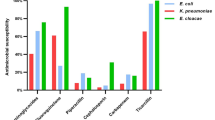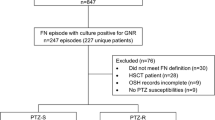Abstract
The aim of this study is to clarify the characteristics of gram-negative bacteremia (GNB), including extended-spectrum β-lactamase (ESBL)-producing pathogens, among allogeneic hematopoietic stem cell transplant (allo-HSCT) recipients on levofloxacin (LVFX) prophylaxis. A retrospective analysis on GNB at the first episode of febrile neutropenia (FN) was conducted among allo-HSCT recipients (age ≥ 20 years) on 500 mg/day of oral LVFX prophylaxis. Epidemiological and microbiological features of GNB were investigated and compared between the inappropriate and appropriate empiric therapy groups. In total, FN occurred in 414 allo-HSCT cases, and bacteremia at the first episode of FN occurred in 169 cases. Overall, 29 GNB cases were documented, and the causative organisms identified were Escherichia coli in 21 cases (including 10 ESBLs), Klebsiella pneumoniae in 2, Pseudomonas aeruginosa in 2, and other in 4. The crude 30-day mortality rate was not significantly different among cases of GNB (6.9%), gram-positive bacteremia (GPB) (7.1%), or non-bacteremia (5.4%; P = 0.78). Cefepime (CFPM) was administered in all cases in the inappropriate empiric therapy group, and all causative organisms were ESBL-producing E. coli (ESBL-EC). All patients in the inappropriate empiric therapy group had a low Pitt bacteremia score (≤ 2). Thirty-day mortality did not differ significantly between the inappropriate and appropriate empiric therapy groups (1/10 vs. 1/15, P = 0.61). In conclusion, GNB was not a significant cause of death. In LVFX breakthrough ESBL-EC bacteremia among allo-HSCT recipients, the administration of CFPM as empiric therapy did not lead to significantly poor prognosis. Empiric CFPM administration might be an acceptable strategy.


Similar content being viewed by others
Data availability
The dataset generated during and/or analyzed during the current study is available from the corresponding author on reasonable request.
References
Klastersky J, Ameye L, Maertens J, Georgala F, Muanza F, Aoun M et al (2007) Bacteraemia in febrile neutropenic cancer patients. Int J Antimicrob Agents 30(Suppl 1):S51–S59
Almyroudis NG, Fuller A, Jakubowski A, Sepkowitz K, Jaffe D, Small TN et al (2005) Pre- and post-engraftment bloodstream infection rates and associated mortality in allogeneic hematopoietic stem cell transplant recipients. Transpl Infect Dis 7:11–17
Poutsiaka DD, Price LL, Ucuzian A, Chan GW, Miller KB, Snydman DR (2007) Blood stream infection after hematopoietic stem cell transplantation is associated with increased mortality. Bone Marrow Transplant 40:63–70
Mikulska M, Del Bono V, Raiola AM, Bruno B, Gualandi F, Occhini D et al (2009) Blood stream infections in allogeneic hematopoietic stem cell transplant recipients: reemergence of gram-negative rods and increasing antibiotic resistance. Biol Blood Marrow Transplant 15:47–53
Tomblyn M, Chiller T, Einsele H, Gress R, Sepkowitz K, Storek J (2009) Guidelines for preventing infectious complications among hematopoietic cell transplantation recipients: a global perspective. Biol Blood Marrow Transplant 15:1143–1238
Freifeld AG, Bow EJ, Sepkowitz KA, Boeckh MJ, Ito JI, Mullen CA (2011) Clinical practice guideline for the use of antimicrobial agents in neutropenic patients with cancer: 2010 update by the infectious disease society of America. Clin Infect Dis 52:427–431
Kanafani ZA, Mehio-Sibai A, Araj GF, Kanaan M, Kanj SS (2005) Epidemiology and risk factors for extended-spectrum beta-lactamase-producing organisms: a case control study at a tertiary care center in Lebanon. Am J Infect Control 33:326–332
Mendelson G, Hait V, Ben-Israel J, Gronich D, Granot E, Raz R (2005) Prevalence and risk factors of extended-spectrum beta-lactamase-producing Escherichia coli and Klebsiella pneumoniae in an Israeli long-term care facility. Eur J Clin Microbiol Infect Dis 24:17–22
Kang CI, Chung DR, Ko KS, Peck KR, Song JH, The Korean Network for Study of Infectious Disease (KONSID) (2012) Risk factors for infection and treatment outcome of extended-spectrum β-lactamase-producing Escherichia coli and Klebsiella pneumoniae bacteremia in patients with hematologic malignancy. Ann Hematol 91:115–121
Horita N, Shibata Y, Watanabe H, Namkoong H, Kaneko T (2017) Comparison of antipseudomonal β-lactams for febrile neutropenia empiric therapy: systematic review and network meta-analysis. Clin Microbial Infect 23:723–729
Masaoka T (2004) Evidence-based recommendations for antimicrobial use in febrile neutropenia in Japan: executive summary. Clin Infect Dis 39:S49–S52
Yamamoto H, Uchida N, Matsuno N, Ota H, Kageyama K, Wada S et al (2014) Anti- HLA antibodies other than against HLA-A, B, DRB1 adversely affect engraftment and nonrelapse mortality in HLA-mismatched single cord blood transplantation: possible implications of unrecognized donor-specific antibodies. Biol Blood Marrow Transplant 20:1634–1640
Giral S, Ballen K, Rizzo D, Bacigalupo A, Horowitz M, Pasquini M, Sandmaier B (2009) Reduced-intensity conditioning regimen workshop: defining the dose spectrum. Report of a workshop convened by the center for international blood and marrow transplant research. Biol Blood Marrow Transplant 15:367–369
Chow JW, Yu VL (1999) Combination antibiotic therapy versus monotherapy for gram-negative bacteraemia: a commentary. Int J Antimicrob Agents 11:7–12
Nourrisson C, Tan RN, Hennequin C, Gibold L, Bonnet R, Robin F (2015) The MAST® D68C test: an interesting tool for detecting extended-spectrum β-lactamase (ESBL)-producing Enterobacteriaceae. Eur J Clin Microbiol Infect Dis 34:975–983
Clinical and Laboratory Standard Institute (2019) Performance standards for antimicrobial susceptibility testing, 29th Edition: CLSI M100-ED29
Kanda Y (2013) Investigation of the freely available east-to-use software ‘EZR’ for medical statistics. Bone Marrow Transplant 48:452–458
Blennow O, Ljungman P, Sparrelid E, Mattsson J, Remberger M (2014) Incidence, risk factors, and outcome of bloodstream infections during the pre-engraftment phase in 521 allogeneic hematopoietic stem cell transplantations. Transpl Infect Dis 16:106–114
Girmenia C, Bertaina A, Piciocchi A, Perruccio K, Algarotti A, Busca A et al (2017) Incidence, risk factors and outcome of pre-engraftment gram-negative bacteremia after allogeneic and autologous hematopoietic stem cell transplantation: an Italian prospective multicenter survey. Clin Infect Dis 65:1884–1896
Bucaneve G, Micozzi A, Menichetti F, Martino P, Dionisi MS, Martinelli G et al (2005) Levofloxacin to prevent bacterial infection in patients with cancer and neutropenia. N Engl J Med 353:977–987
Gafter-Gvili A, Fraser A, Paul M, Leibovici L (2005) Meta-analysis: antibiotic prophylaxis reduces mortality in neutropenic patients. Ann Intern Med 142:979–995
Trecarichi EM, Pagano L, Candoni A, Pastore D, Cattaneo C, Fanci R et al (2015) Current epidemiology and antimicrobial resistance data for bacterial bloodstream infections in patients with hematologic malignancies: an Italian multicentre prospective survey. Clin Microbiol Infect 21:337–343
Kim PW, Wu Y, Cooper C, Rochester G, Valappil T, Wang Y et al (2010) Meta-analysis of a possible signal of increased mortality associated with cefepime use. Clin Infect Dis 51:381–389
Yahav D, Paul M, Fraser A, Sarid N, Leibovici L et al (2007) Efficacy and safety of cefepime: a systematic review and meta-analysis. Lancet Infect Dis 7:338–348
Gudiol C, Calatayud L, Garcia-Vidal C, Lora-Tamayo J, Cisnal M, Duarte R et al (2010) Bacteraemia due to extended-spectrum beta-lactamase-producing Escherichia coli (ESBL-EC) in cancer patients: clinical features, risk factors, molecular epidemiology and outcome. J Antimicrob Chemother 65:333–341
Schwaber MJ, Carmeli Y (2008) Carbapenem-resistant Enterobacteriaceae: a potential threat. JAMA 300:2911–2913
Harris PNA, Tambyah PA, Lye DC, Mo Y, Lee TH, Yilmaz M et al (2018) Effect of piperacillin-tazobactam vs meropenem on 30-day mortality for patients with E coli or Klebsiella pneumoniae bloodstream infection and ceftriaxone resistance: a randomized clinical trial. JAMA 320:984–994
Satlin MJ, Chavda KD, Baker TM, Chen L, Shashkina E, Soave R et al (2018) Colonization with levofloxacin-resistant extended-spectrum β-lactamase-producing Enterobacteriaceae and risk of bacteremia in hematopoietic stem cell transplant recipients. Clin Infect Dis 67:1720–1728
Arnan M, Gudiol C, Calatayud L, Liñares J, Dominguez MÁ, Batlle M et al (2011) Risk factors for, and clinical relevance of, faecal extended-spectrum β-lactamase producing Escherichia coli (ESBL-EC) carriage in neutropenic patients with haematological malignancies. Eur J Clin Microbiol Infect Dis 30:355–360
Tanaka JS, Young RR, Heston SM, Jenkins K, Spees LP, Sung AD et al (2020) Anaerobic antibiotics and the risk of graft-versus-host disease after allogeneic hematopoietic stem cell transplantation. Biol Blood Marrow Transplant S1083-8791(20):30442–0. https://doi.org/10.1016/j.bbmt.2020.07.011
Al-Hasan MN, Lahr BD, Eckel-Passow JE, Baddour LM (2013) Predictive scoring model of mortality in Gram-negative bloodstream infection. Clin Microbiol Infect 19:948–954
Kern WV, Klose K, Jellen-Ritter AS, Oethinger M, Bohnert J, Kern P et al (2005) Fluoroquinolone resistance of Escherichia coli at a cancer center: epidemiologic evolution effects of discontinuing prophylactic fluoroquinolone use in neutropenic patients with leukemia. Eur J Clin microbial Infect Dis 24:111–118
Hakki M, Humphries RM, Hemarajata P, Tallman GB, Shields RK, Mettus RT et al (2019) Fluoroquinolone prophylaxis selects for meropenem-nonsusceptible Pseudomonas aeruginosa in patients with hematologic malignancies and hematopoietic cell transplant recipients. Clin Infect Dis 68:2045–2052
Acknowledgments
We thank the staff of the microbiology laboratory of Toranomon Hospital (Ms Chikako Okada, Ms. Reiko Yabusaki, Ms. Mayumi Yamanaka, Ms. Hiromi Baba, Ms. Noriko Watahiki, Mr. Masaru Baba, Ms. Emiko Miyajima, Ms. Chiemi Yoshino, Ms. Ayumi Takamura, and Mr. Yusuke Endo) for performing tests for identification and antimicrobial susceptibility of ESBL-EC. This research is supported by the Okinaka Memorial Institute for Medical Research, Tokyo, Japan.
Author information
Authors and Affiliations
Contributions
SO and MK designed the study and collected data. SO, MK, and HA analyzed the clinical data. SO and MK wrote the manuscript. SO, MK, ST, TM, MY, KK, DK, AN, YT, KI, HY, YA-M, GY, NU, AW, SU-T, and HA interpreted the results and reviewed the final draft of the manuscript. All authors read and revised the final manuscript before submission.
Corresponding author
Ethics declarations
Conflict of interest
The authors declare that they have no conflict of interest.
Consent to participate
The protocol of this retrospective study was evaluated by the Human Ethics Review Committee of Toranomon Hospital and waived from the requirement of patient informed consent.
Consent to publish
All the authors reviewed this study and agreed to publish this manuscript.
Ethics approval
This study was approved by the Human Ethics Review Committee of Toranomon Hospital.
Additional information
Publisher’s note
Springer Nature remains neutral with regard to jurisdictional claims in published maps and institutional affiliations.
Rights and permissions
About this article
Cite this article
Ogura, S., Kimura, M., Takagi, S. et al. Characteristics of gram-negative bacteremia during febrile neutropenia among allogeneic hematopoietic stem cell transplant recipients on levofloxacin prophylaxis. Eur J Clin Microbiol Infect Dis 40, 941–948 (2021). https://doi.org/10.1007/s10096-020-04096-z
Received:
Accepted:
Published:
Issue Date:
DOI: https://doi.org/10.1007/s10096-020-04096-z




